紫陽花の原種はこちらだったのですね(愛知県名古屋市千種区姫池通 骨董買取 古美術風光舎)
2024.06.11
皆さまこんにちは。スタッフでHございます。
今朝歩いていると、色々な種類の紫陽花(あじさい)が咲いている公園をみつけました。私のイメージする紫陽花はこんもりと丸いブーケのような形なのですが、花が周りにだけ咲いている紫陽花も時々みかけます。(この花だと思っていたものは実は花ではなかったのですが…)
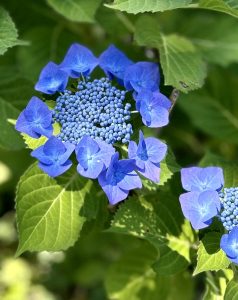
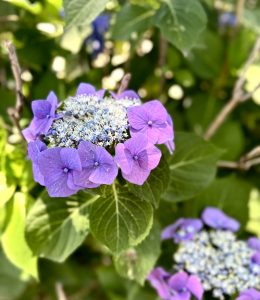
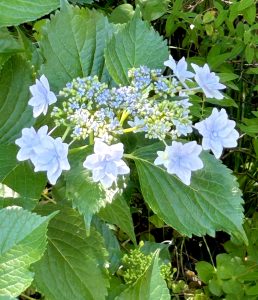
調べてみるとこちらの種類の方が原種で「ガクアジサイ」と呼ばれ、丸いブーケの形の方が品種改良されたものだそうです。
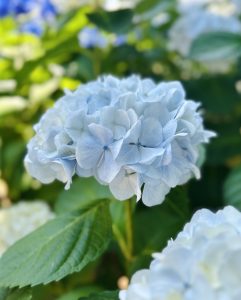
紫陽花は日本原産の落葉低木である「ガクアジサイ」を原種とする園芸品の総称とされています。18世紀に西洋に渡り、「東洋のバラ」として珍重されるようになりました。
紫陽花の種類は2000とも3000ともいわれ、毎年無数の新品種が登場するため確かな品種数は分かっていないそうです。2000と3000でも随分差があると思いますが…。
ただその原種が日本固有の植物であったガクアジサイだとしたら、なんだか誇らしい気持ちになります。
先ほど、花に見えるものは花ではないそうで…と書きましたが、ガクアジサイの周囲を囲む4枚の花弁に見えるものは花ではなく「がく」だそうで「装飾花」と呼ばれます。「がく」とは花びらの外側にある花葉のことで、普通は葉と同じ緑色をしていますが、紫陽花は花のようにカラフルな色をしています。
中央の複数の小さな粒のようなものの一つ一つが花だということです。よく見ると青い紫陽花の中心はまだ蕾で、紫の紫陽花の中心の花は咲いているように見えます。水色のガクアジサイの「がく」は八重になっており、もう私には花にしか見えません!
ブーケのような紫陽花も4枚の花弁に見えるものは「がく」でその中心に小さな小さな花が一つ咲いています。控えめすぎるお花です。
色々と調べてみますと「アジサイ」の語源は「アジ」が小さいものが集まることを意味する「あづ」。「サイ」が藍色を意味する「真藍(さあい)」からきていると分かりました。
漢字の「紫陽花」は平安時代中期の歌人であり学者でもあった源順(みなもとの したごう)という人物が中国の白楽天の詩に登場する「紫陽花」の花の特徴から、ガクアジサイを同じ花だと勘違いし、この漢字を当てたといわれています。あじさいは日本原産ですので中国の紫陽花とは同じ花ではないとされていますが、現代までこの漢字は受け継がれ、紫陽花という文字を見ると日本の梅雨の時期のしっとりとした情景が思い浮かびます。
ふと思い出したのですが、昔実家でトイレに紫陽花が逆さまに吊るされていた時期がありました。
昔の人は紫陽花には霊力が宿るとして魔除けに使っていたようで、紅白の水引で結んだものを軒先や玄関に吊るすのだそうですが、なぜトイレに?と不思議に思い調べると、トイレに吊るすと婦人病を防ぐという言い伝えがあるのだそうです。今朝も家の庭先に咲くたくさんの紫陽花を見ました。家を守るという意味合いもあるのかもしれませんね。
紫陽花の花の色は土壌の酸性度によって変化するようで、酸性に近ければ青色の花が咲き、アルカリ性に近ければピンクの花が咲くそうです。土壌が弱酸性の日本では青色の紫陽花が多く見られ、今朝見つけた公園でも水色や紫の紫陽花が咲いていました。今日は日差しが強くバテ気味でしたが、涼し気な色の紫陽花が一瞬暑さを忘れさせてくれ、元気をもらいました。
それでは、また次の機会に。
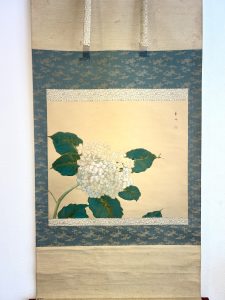
Hello everyone. This is Staff H.
When I was walking this morning, I found a park with various kinds of hydrangeas in bloom. My image of hydrangea is a rounded bouquet, but sometimes I see hydrangeas with flowers only around them. (What I thought were flowers were not actually flowers…).
I found out that this type of hydrangea is the original variety and is called “Gaku hydrangea” and the round bouquet type is the bred variety.
Hydrangea is a generic name for horticultural products derived from the Gaku hydrangea, a deciduous shrub native to Japan, which was introduced to the West in the 18th century and came to be prized as “the rose of the East.
There are said to be as many as 2,000 or 3,000 varieties of hydrangea, and the number of varieties is not known for sure, as countless new varieties appear every year.
However, if the original species is the Gaku hydrangea, which was a plant indigenous to Japan, I feel proud of it.
I mentioned earlier that what looks like a flower is not a flower, but what looks like four petals surrounding a gaku hydrangea is not a flower but a “gaku” (stem), which is called an “ornamental flower. The “kaku” is the outer leaf of the petal, which is usually the same green color as the leaf, but the hydrangea is colorful like the flower.
Each of the multiple small grain-like things in the center is a flower. If you look closely, you can see that the center of the blue hydrangea is still a bud, while the center flower of the purple hydrangea appears to be blooming. The light blue gaku hydrangea’s “buds” are double-layered, and they already look like flowers to me!
The bouquet-like hydrangea also has what looks like four petals, but is actually a “bud” with one tiny little flower in the center. It is too modest a flower.
I have researched the origin of the word “hydrangea” and found that “aji” is derived from “azu,” meaning a gathering of small things, and “sai” means indigo. I found out that “sai” is derived from “saai” meaning indigo color.
The Chinese character for “hydrangea” is said to have been applied by a mid-Heian period poet and scholar named Minamoto no Shitagoh, who mistakenly thought that the Chinese character for “hydrangea” in a poem by the Chinese poet Hakurakuten was the same flower as the Chinese character for “gaku hydrangea” based on the characteristics of the flower. Since hydrangea is native to Japan, it is said that it is not the same flower as the Chinese hydrangea, but the Chinese character for hydrangea has been handed down to the present day, and the word “hydrangea” brings to mind the moist scene of the rainy season in Japan.
I remember a time when hydrangeas were hung upside down in the bathroom at my parents’ house.
It seems that people in the old days used hydrangeas to ward off evil spirits as they were believed to possess spiritual power, and they would tie them with red and white mizuhiki and hang them from the eaves of the roof or the front door. I wondered why they hung them in toilets and found out that there is a legend that hanging them in toilets prevents women’s diseases. This morning, I saw many hydrangeas blooming in my yard. Perhaps they are meant to protect the house.
It is said that the color of hydrangea flowers changes depending on the acidity of the soil, with blue flowers blooming when the soil is acidic and pink flowers blooming when the soil is alkaline. In Japan, where the soil is mildly acidic, blue hydrangeas can be seen in abundance, and in a park I found this morning, light blue and purple hydrangeas were in bloom. The sun was strong today and I was feeling a bit tired, but the cool colored hydrangeas made me forget the heat for a moment and cheered me up.
I will see you next time.
*******************
ご実家の整理やお片付けなどをされている方のご相談などが多くございます。
お片付けなどくれぐれもご無理のないようになさってくださいませ。
風光舎では古美術品や骨董品の他にも絵画や宝石、趣味のお品など様々なジャンルのものを買受しております。
お片付けをされていて、こういうものでもいいのかしらと迷われているものでも、どうぞお気軽にご相談下さいませ。
また風光舎は、出張買取も強化しております。ご近所はもちろん、愛知県内、岐阜県、三重県その他の県へも出張いたします。
まずは、お電話お待ちしております。
愛知県名古屋市千種区姫池通
骨董 買取【古美術 風光舎 名古屋店】
TEL052(734)8444
10:00-18:00 OPEN

